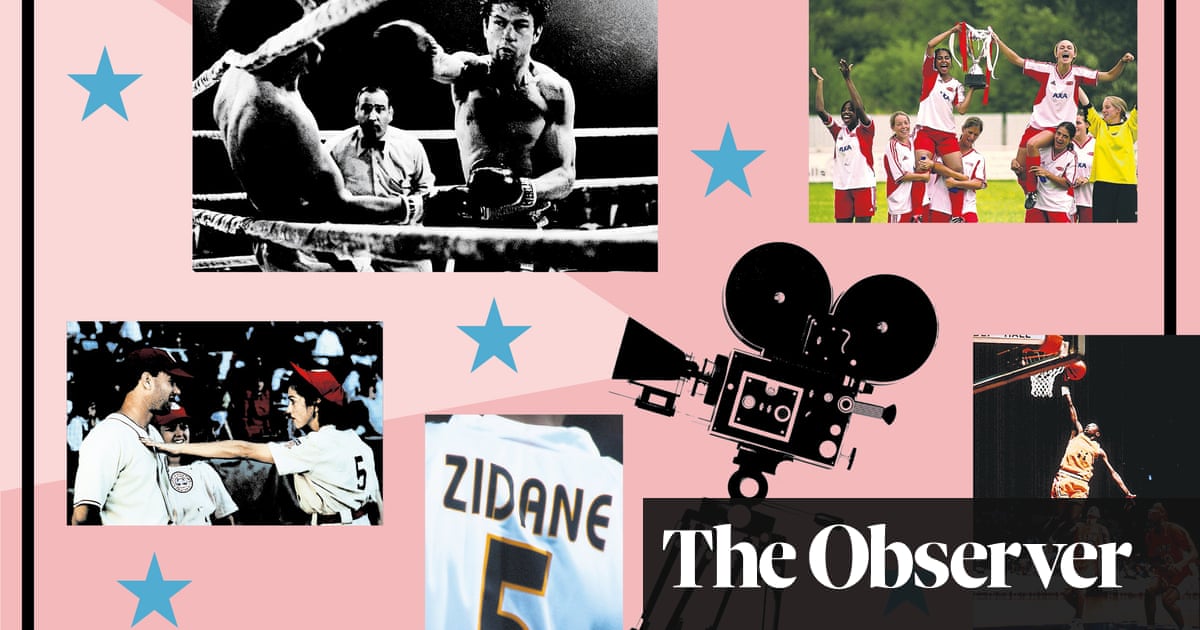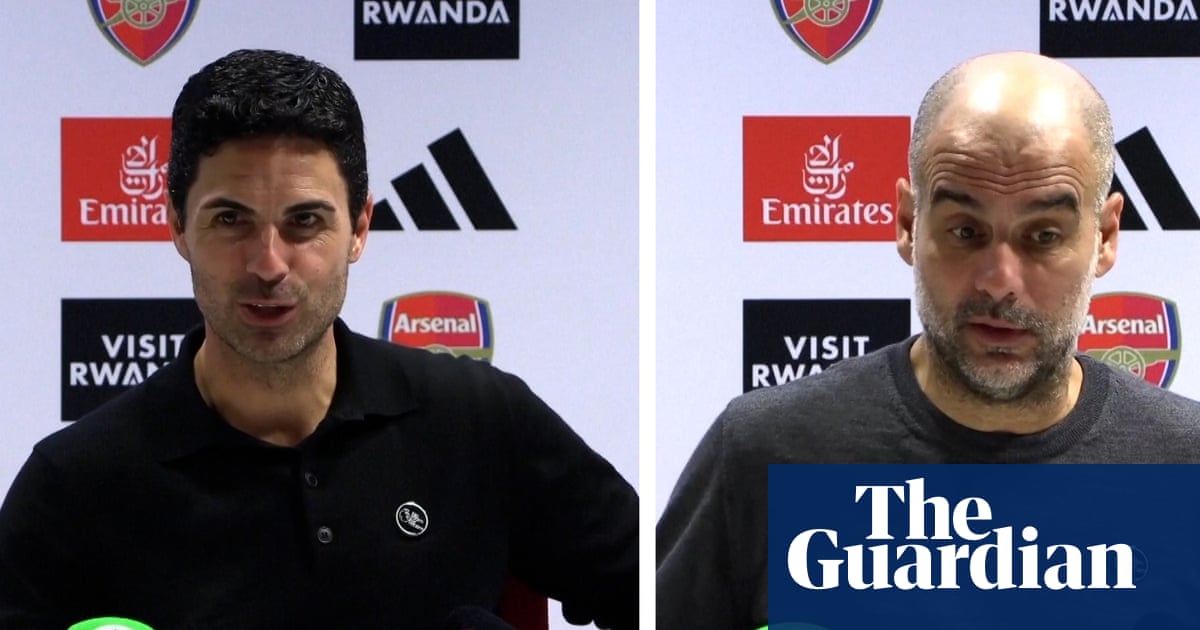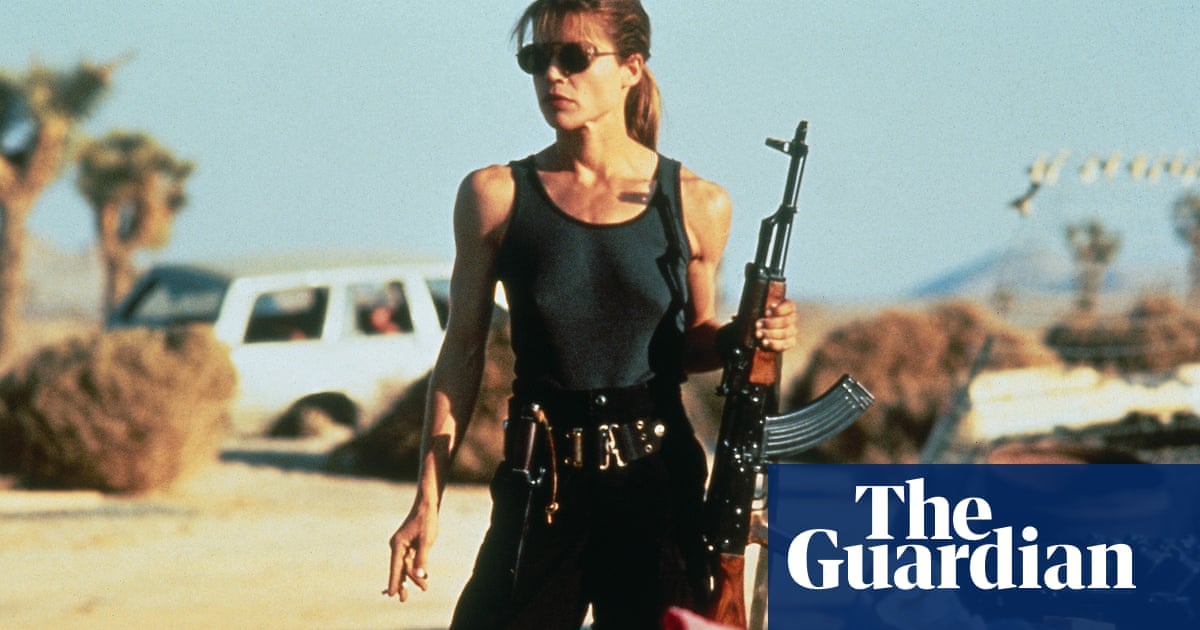
Analogies of life as sport have been exhausted by every PE teacher in existence. In the movies, however, they’re eternally renewable. Take Challengers, Luca Guadagnino’s sleek, sexy, sweat-drenched new film, which hits every metaphor you might expect in its story of three tennis pros locked in a tense love triangle: games are won and lost, points scored, doubles partners swapped, and so on. Shot and paced with the ricocheting energy of a great tennis match, it’s a sports movie that, like many a classic of the genre, understands the parallels between sport and cinema as two great crowd-pleasing pastimes.
The sports movie is pretty much as old as movies themselves: for early silent-cinema pioneers at the turn of the 20th century, the movement and momentum of a baseball game or a boxing match made them as dynamic a subject as any for the camera. Charlie Chaplin’s very first appearance as the Little Tramp, in the short Kid Auto Races at Venice, cast him as a disruptive spectator at a racing-car derby. Classic templates for the genre emerged quickly: the Oscar-winning 1931 hit The Champ nailed a structure for the underdog sporting weepie that shaped everything from Rocky to The Wrestler, while the 1944 Elizabeth Taylor vehicle National Velvet minted a million further feelgood stories of plucky athletes defying the odds. (It’s far harder to involve audiences in stories of an athlete who’s born a winner.)
Today, the genre continues to thrive, in forms both familiar and more boundary-pushing, from King Richard to The Iron Claw. One of the year’s highest-grossing films so far worldwide is the Chinese smash comedy YOLO, about a downtrodden woman who finds a new lease of life in boxing; it hits every cliche in the book, but proves they still work with audiences. Less expectedly, Rose Glass’s forthcoming neo-noir Love Lies Bleeding (out next week) finds thrilling erotic energy and macabre wish-fulfilment in the niche world of 1980s bodybuilding. You needn’t have any interest in the sport at hand to get caught up in it on film: the best examples of the genre will make you feel the burn.
Bend It Like Beckham
(2002, director Gurinder Chadha)
The world’s most popular sport has a surprisingly spotty record at the movies, but football films work best the more unassuming they are, which is why Gurinder Chadha’s scrappy teen comedy is such an enduring crowdpleaser. The winning story of a British Punjabi girl defying her disapproving parents to pursue her dreams on the pitch, it was a welcome reminder of the sport’s culture-crossing appeal.
Best for: Showing girls that football isn’t a man’s world.
Bull Durham
(1988, Ron Shelton)
Baseball may be the most all-American sport there is, conjuring images of wholesome, Norman Rockwell-esque masculinity, but it never looks very sexy, does it? Maybe it’s the kit – like very tight but oddly unflattering pyjamas. Anyway, this steamy, sweaty, grownup romcom is a glorious exception, powered by the bristling chemistry between Kevin Costner’s veteran minor-league catcher and Susan Sarandon’s dedicated baseball groupie, who shows new players the ropes in her own special way. Director Ron Shelton specialises in sports movies – he also made the zingy White Men Can’t Jump and re-teamed with Costner for the improbably charming golf comedy Tin Cup – but this, his first time at bat, remains his best.
Best for: Those who like sport as foreplay.
Gregory’s Girl
(1981, Bill Forsyth)
Another disarming, British coming-of-age film built around football, though the beautiful game in this case is less important to its young, awkward characters than a different kind of scoring. Gawky Scottish 16-year-old Gregory (John Gordon Sinclair) is demoted on the football team and hot for his female replacement Dorothy (Dee Hepburn) – he’s a rare model of masculine humility in the genre, on the pitch and off.
Best for: Teenage boys with a bout of puppy love.
Hoop Dreams
(1994, Steve James)
Steve James’s extraordinary documentary portrait of two black Chicago teenagers trying to make their way into professional basketball via the high school leagues was shot over five years, winnowing 250 hours of footage down to one enthralling three-hour epic. It’s one of cinema’s great studies of sport as a vessel of hope: tough futures await its embattled subjects if they don’t make an impression in these few, tender years, as personal and financial setbacks keep making things harder. The challenges of being young, gifted and black in America have rarely been so expansively mapped out on screen.
Best for: Demonstrating the intersection of sport and social issues.
John McEnroe: In the Realm of Perfection
(2018, Julien Faraut)
The greatest of all tennis films might just be this underseen documentary. Ostensibly about the famously hotheaded John McEnroe, Julien Faraut’s film rejects dull bio-doc treatment for a thrillingly and suitably experimental study of movement, space and time. Intricately scrutinising a wealth of 16mm footage from McEnroe’s 1984 French Open final, it draws a fevered parallel between cinema and sport, appealing to nerds of multiple persuasions.
Best for: Tennis fans convinced of their sport’s ultimate refinement.
Lagaan
(2001, Ashutosh Gowariker)
Test cricket, that most luxuriously time-consuming of all sports, gets a suitably sprawling valentine in this near four-hour Bollywood epic, which examines late-Victorian colonial tensions in a central Indian village through the prism of one crucial cricket match. Challenged by a haughty British army officer to the game, with their tax debt on the line, the oppressed locals begin to learn the unfamiliar sport and – well, what do you think happens? Contrived to the last, with everyone’s fate hanging on the very last ball, it’s also utterly irresistible, fired by the blazing charisma of Indian superstar Aamir Khan, and sweeping, old-school film craft.
Best for: A rousing triumph of good over evil.
A League of Their Own
(1992, Penny Marshall)
“There’s no crying in baseball!” Blame early-90s misogyny or critical anti-Madonna bias, but Penny Marshall’s buoyant girl-power baseball comedy was treated as little more than agreeable fluff on its release. But it’s aged very well indeed: a warmly classical family entertainment in which the empowering gender messaging doesn’t swamp the spry good spirits of it all. Madonna’s pretty good in it too.
Best for: The Venn diagram overlap of baseball and Madonna fans. Or anyone, really.
The Loneliness of the Long Distance Runner
(1962, Tony Richardson)
The title of Tony Richardson’s hard, sharp 1962 slap of new British realism entered the general sporting lexicon (it was based on Alan Sillitoe’s 1959 book), capturing as it does the romance and severity of a most solitary sport – surely more people have quoted it than have seen the film. But it remains a beauty: a testament to the head-clearing virtues of athletics, and the occasional power of losing.
Best for: The serious, solitary film watcher.
Murderball
(2005, Dana Adam Shapiro and Henry Alex Rubin)
The world of disabled sports hasn’t yet had its crowning mainstream moment in the movies, but this propulsive, Oscar-nominated documentary by Henry Alex Rubin and Dana Adam Shapiro was an arthouse hit – one that could easily have been fashioned into a fictional crowdpleaser. Centred on the very tough guys who play wheelchair rugby, and playing up the rivalry between the US and Canadian teams ahead of the Paralympic Games, it’s less fixated on sob stories than on the kinetic dynamics of the sport itself, amplified by a pummelling metal soundtrack, and the formidable capabilities of its players on and off the court. (It may be rugby, but it’s played on basketball facilities.)
Best for: Smashing the ableism of the athletic world.
Offside
(2006, Jafar Panahi)
To most football fans, a 2006 World Cup qualifying match between Iran and Bahrain wouldn’t have been much of an event, but in Iranian auteur Jafar Panahi’s sly, humane comedy, it’s the object of a bravely defiant quest. Forbidden by gender law from entering a football stadium, a group of young, football-mad Iranian women disguise themselves as men in the hope of watching their national team play. What ensues isn’t just a political screed – though it makes a pointed case for not judging Iran by its systemic inequalities – but a thoughtful, playful essay on degrees of spectatorship, and how sporting patriotism can unify some populations and exclude others.
Best for: An unlikely fusion of sport, comedy and politics.
Over the Limit
(2017, Marta Prus)
This bruising documentary by Polish director Marta Prus hasn’t been widely seen, but it’s unforgettable once you do: candidly documenting the abusive training endured by a Russian rhythmic gymnast on the road to the Olympics, it maintains a nervy tension between the pristine physical beauty of her athleticism and the ugly mental warfare behind it.
Best for: Edge-of-your-seat viewing of a different kind.
Personal Best
(1982, Robert Towne)
An exceptionally rare Hollywood sports drama focused on queer characters, Robert Towne’s taut, tender film about two female track-and-field athletes whose romance complicates their Olympic training was a box office flop back in 1982. It now stands as a commendably ahead-of-its-time study of sexual fluidity, and while some may decry its male gaze given the subject, the film has a keen, close eye for the wear and tear of the professional athletic body, given added authenticity by the casting of real-life hurdling champion Patrice Donnelly in a lead role.
Best for: Any LGBTQ+ sports fans who feel unseen.
Raging Bull
(1980, Martin Scorsese)
The boxing drama is such a vast genre unto itself that I had to curb its presence on this list, but there was no leaving out the harsh poetry of Martin Scorsese’s Jake LaMotta biopic, with its transformational, Oscar-winning Robert De Niro turn as the troubled middleweight champ. A second Oscar went to Thelma Schoonmaker’s editing, the quick, jabbing rhythms of which changed how boxing was shown on film.
Best for: Anyone who’s wanted to feel like they’re in the ring.
Rocky
(1976, John G Avildsen)
Likewise, there had to be room for the most beloved underdog story in film history: Sylvester Stallone’s bloated ego and sundry cheesy sequels may have tainted its legacy, but the 1976 original still has honest soul to it, and a gotta-lose-to-win ending that puts a lump in the throat.
Best for: Those tired of celebrating the winners.
Senna
(2010, Asif Kapadia)
Anyone who witnessed champion Formula One driver Ayrton Senna’s tragic death in real time during the 1994 San Marino Grand Prix is likely still haunted by the memory. Eschewing standard-issue talking heads and voiceover, Asif Kapadia’s elegiac documentary reconjures the memory, but not luridly so, instead seeking the soul of a man who thrived on speed and risk. Brilliantly assembled archival footage, meanwhile, presents the sport itself so viscerally that we understand the obsession for ourselves.
Best for: Racing fans in need of a reality check.
Small, Slow But Steady
(2023, Shô Miyake)
One of last year’s overlooked gems, Japanese director Shô Miyake’s stoically moving character study semi-fictionalises a memoir by deaf female boxer Keiko Ogasawara – the kind of story that could easily be told as a mawkish tearjerker. Instead, Miyake and star Yukino Kishii exercise terse restraint, as the film expands its view to include a whole hard-up, hard-working independent boxing community in modern Tokyo.
Best for: A shot of the everyday in a genre given to the exceptional.
Sugar
(2008, Anna Boden and Ryan Fleck)
Baseball embodies the American dream for an immigrant Dominican pitcher determined to make it in the US minor leagues: Anna Boden and Ryan Fleck’s lyrical, compassionate indie is both a closeup individual portrait of desperate determination and an illuminating view of national sporting systems that can’t accommodate everyone’s ambition.
Best for: Spotlighting the individual struggles in team sports.
This Sporting Life
(1963, Lindsay Anderson)
The battering, ravaging crash and crunch of male bodies in rugby league has never been quite so vividly depicted as in Lindsay Anderson’s rough-and-ready kitchen sink drama. Starring an extraordinary Richard Harris as a Yorkshire coalminer and rugger bugger who can’t shed his combative on-the-pitch demeanour in his domestic life, it’s not much of an advertisement for sport’s redemptive powers, but its portrayal of mutually aggravating physical and mental injuries hits hard.
Best for: A cold slap of working-class sporting reality.
Tokyo Olympiad
(1965, Kon Ichikawa)
Akira Kurosawa was initially hired by the Japanese government to document the 1964 Tokyo Olympics on film; when he bowed out, meditative formalist Kon Ichikawa stepped in. His serene, process-driven ode to motion and spectatorship wasn’t the rousing patriotic propaganda the government had in mind, and it was severely recut, but the 165-minute original is a thing of grace and beauty.
Best for: Getting yourself amped up for this year’s Games.
Zidane: A 21st Century Portrait
(2006, Douglas Gordon)
Seventeen synchronised cameras follow French midfielder Zinédine Zidane over the course of one La Liga match: the surrounding game fades into the background as we zero on one player’s inch-by-inch movement. Football has never been this balletic.
Best for: The simple spectacle of a body in motion.












